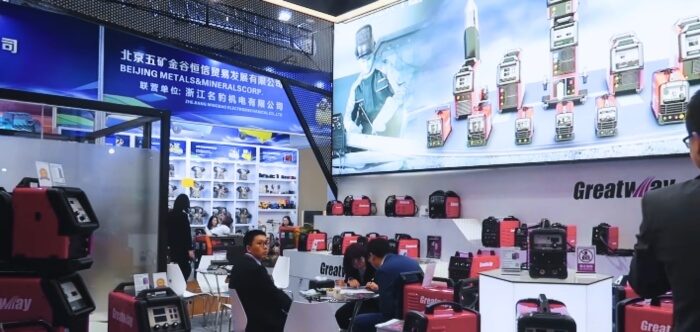Trade shows are lively hubs of innovation and networking, but often, attendees are left pondering over the best way to communicate with vendors. Breaking the ice and building connections in this dynamic environment is key to maximizing your experience. But, “How do you talk to vendors at a trade show?”
To effectively engage with vendors, it’s important to approach them with a friendly demeanor, introduce yourself confidently, and show genuine interest in their offerings. Asking open-ended questions helps stimulate engaging conversations, while active listening demonstrates your interest and respect.
Don’t forget to exchange business cards. Exchanging business cards is a critical step for future communications. For more insightful strategies on effective vendor communication, continue reading our detailed article.
What is the Core Purpose of Vendors at a Trade Show?
Vendors at trade shows primarily aim to showcase their latest products or services. These events serve as a platform for them to connect with potential clients and partners. It’s an opportunity to expand their market reach and brand visibility.

Interacting directly with customers is a vital aspect for vendors. They gather feedback and insights on their offerings, which is invaluable for future development. Personal interactions also help in building lasting business relationships and brand loyalty.
Additionally, trade shows are a hub for networking and industry trends. Vendors stay abreast of market dynamics and competitor strategies. This knowledge helps them innovate and stay competitive in their respective fields.
How Do You Talk to Vendors at a Trade Show?
The trade show offers an exciting opportunity to explore new products and network with industry professionals. To make the most of these events, it’s crucial to know how to effectively communicate with vendors. Here’s a step-by-step guide on how do you talk to vendors at a trade show:

Step 1: Prepare Your Introduction
Before you approach a vendor, develop a well-thought-out introduction. Mention your name, company, role, and what you hope to gain from the trade show. This preparation not only sets a professional tone but also gives vendors immediate context to tailor their responses to your interests.
Step 2: Show Genuine Interest
When engaging with vendors, show real enthusiasm for what they offer. Ask about the development process, any unique features, and how their products stand out in the market. This level of inquiry not only elicits detailed responses but also shows that you value their work and expertise.
Step 3: Use Open-Ended Questions
Encourage vendors to share more by asking open-ended questions. Queries like “What inspired this product’s design?” or “How have clients benefited from your services?” allow for more engaging and informative conversations.
Step 4: Practice Active Listening
Focus on understanding their points fully. Reflecting on what they say and asking follow-up questions not only shows your interest but also helps in building a meaningful connection and ensuring you have all the information needed.
Step 5: Discuss Your Needs
Talk about specific challenges or needs your business faces and see how their offerings might provide solutions. This approach helps the vendor understand your situation better and propose more relevant and customized solutions.
Step 6: Exchange Business Cards
Make sure to exchange business cards at the end of your conversation. This formal exchange is not just about contact information; it symbolizes an interest in further dialogue and potential collaboration.
Step 7: Follow-Up After the Show
After the trade show, send a personalized follow-up message or call. Mention specific details from your conversation to reinforce your interest and the potential for a business relationship. Timely and personalized follow-ups can significantly increase the chances of developing a fruitful professional relationship.
Effectively communicating with vendors at a trade show is about preparation, engagement, and follow-through. By applying these steps, you’ll not only make meaningful connections but also lay the groundwork for future business prospects. Remember, every interaction is an opportunity to learn, network, and grow.
Significance of Proper Talking With Vendors at a Trade Show
Engaging with vendors at trade shows is more than just casual conversation; it’s a strategic business practice. Effective communication can unlock numerous opportunities and benefits. Mastering this skill can significantly enhance your trade show experience.
- Builds Professional Relationships: Talking properly with vendors helps in forming lasting business relationships. It’s the first step in networking and creating future collaboration opportunities.
- Gathers Market Insights: Through meaningful conversations, you can gain valuable insights into market trends and innovations. This information is crucial for staying ahead in your industry.
- Enhances Brand Image: Articulate and respectful communication reflects positively on your personal and company brand. It leaves a lasting impression of professionalism and competence.
- Facilitates Product Understanding: Engaging discussions provide a deeper understanding of products and services. This knowledge is vital for making informed business decisions.
- Identifies Potential Partnerships: Effective communication can reveal opportunities for partnerships and collaborations. These connections can lead to mutually beneficial business ventures.
- Enables Custom Solutions: By clearly expressing your needs, vendors can offer tailored solutions. This customization can lead to more effective and efficient outcomes.
- Promotes Learning and Growth: Each conversation is a learning opportunity about new technologies, strategies, and industry challenges. This growth is invaluable for personal and professional development.
Proper communication with vendors at trade shows is a powerful tool for business growth and networking. It opens doors to new opportunities, partnerships, and a wealth of industry knowledge. Remember, each conversation can be a stepping stone to success.
Factors to Consider While Talking to Vendors at a Trade Show
At trade shows, your interactions with vendors can make or break potential business opportunities. Understanding the nuances of these conversations is key to a successful experience. Here are some essential factors to consider when talking to vendors, structured to guide you in maximizing your trade show interactions.

Knowing Vendor’s Products/Services
Begin by thoroughly understanding what the vendor offers. Ask specific questions about the product’s features, benefits, and applications. This shows your interest and helps assess its relevance to your needs. Understanding their products enables more meaningful discussions about potential collaborations.
Clear Communication of Your Needs
Be explicit about what you’re looking for. Describe your business needs, challenges, and what you hope to find at the trade show. This clarity helps vendors offer tailored solutions and suggestions. Clear communication prevents misunderstandings and ensures both parties are on the same page.
Evaluating Vendor’s Expertise and Reliability
Assess the vendor’s knowledge and credibility. Listen to how they discuss their products and handle questions. Their expertise is a good indicator of product quality and reliability. This evaluation helps in deciding whether to pursue a business relationship.
Discussing Cost and Value Proposition
Don’t shy away from discussing pricing and value. Understanding the cost-benefit analysis is crucial for making informed decisions. Ask about pricing, discounts, and the value their product brings. This information is vital for budget planning and ROI calculations.
Exploring Customization and Support Options
Inquire about customization options and post-purchase support. Understanding their flexibility in tailoring products and offering support is essential. This factor is particularly important if you’re looking for long-term vendor relationships. It also gives insight into their customer service approach.
Measuring Long-Term Potential and Scalability
Consider the long-term potential of their products or services. Discuss how their offerings can scale with your business growth. Understanding their vision for the future helps in evaluating them as a long-term partner. This foresight is crucial for sustainable business planning.
Engaging effectively with vendors at trade shows requires a blend of keen observation, clear communication, and strategic questioning. By considering these factors, you can establish fruitful connections and make informed decisions. Remember, every conversation is a chance to discover opportunities that could shape the future of your business.
Dos and Don’ts of Vendor Communication
Effective communication with vendors are essential for successful business interactions. Here are crucial dos and don’ts to manage vendor communication and foster productive relationships.
Dos
- Prepare Thoroughly: Research the vendor’s background, products, and industry trends. This knowledge will enable you to ask insightful questions and show genuine interest in their offerings.
- Be Clear and Concise: Express your objectives and expectations clearly. When discussing your needs, provide context and specific examples to help vendors understand your requirements better.
- Listen Actively: Beyond just hearing the vendor’s words, actively engage in the conversation by nodding, making eye contact, and asking follow-up questions. This demonstrates your attentiveness and respect for their expertise.
- Ask Relevant Questions: Inquire about not only the features and benefits of their products but also their track record, customer testimonials, and case studies. This comprehensive approach helps in making informed decisions.
- Maintain Professionalism: Be polite, respectful, and punctual in all interactions. Building a professional rapport fosters trust and lays the foundation for successful collaborations.
- Follow Up Promptly: After initial discussions, send a personalized follow-up email or message. Reference key points from your conversation to reinforce your interest and show that you value the connection.
Don’ts
- Overstate or Overpromise: Avoid making grand claims or promises that you may not be able to fulfill. Honesty is the best policy in vendor relationships.
- Underestimate Their Expertise: Respect the vendor’s expertise and industry knowledge. Avoid belittling their insights or suggestions; instead, seek to learn from them.
- Use High-Pressure Tactics: Refrain from applying undue pressure or creating a sense of urgency during negotiations. Such tactics can strain the relationship and lead to unfavorable outcomes.
- Neglect Follow-Up: Don’t disregard follow-up communications from vendors. Timely responses and acknowledgments are essential to maintain professionalism and demonstrate continued interest in potential collaborations.
These dos and don’ts serve as a roadmap for nurturing fruitful vendor relationships. By following these principles, you not only enhance your business interactions but also pave the way for long-term collaboration and success in the dynamic world of trade shows and negotiations.
Bottom Line
Mastering the art of communication with vendors at trade shows is the key to unlocking a world of opportunities and maximizing your experience. “How do you talk to vendors at a trade show?” is a question that holds the power to connect, learn, and grow. By following the steps outlined in this comprehensive guide, you can confidently engage with vendors, build lasting relationships, and gain valuable insights.
Understanding the core purpose of vendors at trade shows reveals their dedication to showcasing innovations, connecting with potential clients, and gathering feedback. This direct interaction is a goldmine of information, not only for vendors but also for attendees looking to stay ahead in their industry.
As you step into your next trade show, remember that each conversation is a stepping stone to success. So, embrace the opportunity, ask those open-ended questions, and exchange business cards. With the right approach, you can harness the full potential of vendor interactions and make your trade show experience truly rewarding.


